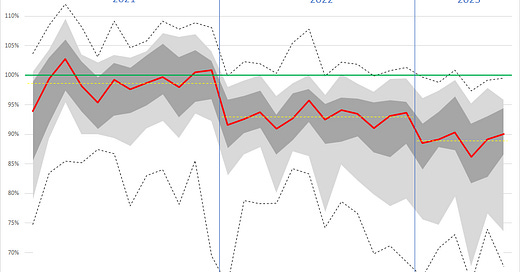I have reorganized and expanded my collection of data on monthly births figures for Europe (and a few neighbours).
For 25 countries, timely tracking is possible: Germany, France, Switzerland, Austria, Northern Ireland, Scotland, Sweden, Portugal, Spain, Netherlands, Belgium, Norway (h/t Stephan Sander-Faes for pointing to the source), Israel, Italy, Denmark, Finland, Poland, Estonia, Latvia, Lithuania, Romania, Slovenia, Czech Republic, Slovakia and Hungary.
As before, I plotted monthly births against the 2017-2020 median (in the Excel file, “vs_4”), and computed quantiles of the resulting distributions of quotients:
The second quarter of 2023 confirms the trend of the first quarter. While 2021 saw an average median (weird concept, that one; dashed yellow line in the diagram) of close to 99%, 2022 fell to 93%, and 2023 to 89%. It remains a bit of a mystery why the calendar year should play such an important role. Investigation should concentrate on what happened in March or April the year before.
In addition, partial data (for example, only data for 2022, or only quarterly data) are available for 11 countries: England & Wales, Ireland, Albania, Turkey, Bulgaria, Bosnia and Herzegovina, Serbia, Croatia, Moldova, Kosovo and North Macedonia. Maybe Bosnia and Herzegovina (lagging a bit) and Serbia (births by month of registration, and not by month of occurrence) will be promoted to the “full data” section next time. The “home” sheet compares cumulative 2022 and 2023 figures for all 36 countries against the 2017-2021 median. The study of cumulative figures has a smoothing effect:
Of all the countries in Europe with more than one million inhabitants (I skip the smaller ones because I do not want discreteness to confound the results), only Russia, Ukraine, Belarus and Greece are missing.
On the “fun” sheet I am computing correlations of various variables with the 2022 effects on birth rates. If that is your idea of fun as well, and if you have any additional suggestion, please come forward.





Great work!
I am curious as to why you would include pandemic years in the baseline.
I have used 2015-2019 inclusive as a baseline for "extra" (not excess) deaths and tried to parse out 2020 as a C19 only year, then 2021 as a partially vaxxed year and 2022 and 2023 as fully vaxxed years.
This does not adjust for the different strains of the SARS-COV2 virus - but gives a "feel" for what is going on.
To be clear, I don't believe there ever was a pandemic - most (95%) of C19 cases and deaths were misdiagnosed as "caused" by C19. 95% of deaths with C19 present were actually "death by healer" (murder) or preventable with antibiotics or were from cessation of existing treatments for other conditions.
I have cross posted this article as I think it has quality and valuable info!
The calendar year effect could be explained by birth not being immediately registered at birth. The birth statistics can be backed filled. Check out the British Columbia Vital Statistics.